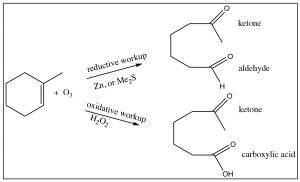7.2: Preparations of Carboxylic Acids
- Page ID
- 354665

All the derivatives of carboxylic acids can be produced from the acid form, although it may occur via the acid chloride. We have also seen several reactions in which carboxylic acids can be produced by alternative mechanisms: for example, via the oxidation of primary alcohols or aldehydes. It turns out that we can also produce acids by ozonolysis (reaction with ozone \(\mathrm{O}_{3}\)) if one or both of the alkene carbons are bonded to a hydrogen. When we looked at such reactions previously, they were accompanied by a reductive workup (either \(\mathrm{Zn}\), or dimethyl sulfide) and arrested at the aldehyde level. If instead we use an oxidative workup with hydrogen peroxide, the oxidation goes all the way through to the carboxylic acid.

Another reaction that is often used to produce carboxylic acids is the hydrolysis of nitriles (\(\mathrm{RCN}\)). The nitrile carbon is at the same oxidation state as a carboxylic acid, and when treated with aqueous acid (or base), it undergoes a hydrolysis reaction in just the same way as we have seen on numerous occasions (try it—you will see!).
Finally, a different approach to producing carboxylic acids occurs when we react a Grignard reagent (or alkyl lithium) with carbon dioxide. You may recall from general chemistry that \(\mathrm{CO}_{2}\) is a linear molecule and has no overall molecular dipole. However, each \(\mathrm{C=O}\) bond in the molecule is polarized, leading to a partial positive charge on the central carbon that makes it susceptible to nucleophilic attack. Therefore, when reacted with a Grignard reagent, the end result is the formation of a new \(\mathrm{C-C}\) bond with the \(\mathrm{CO}_{2}\) becoming a carboxyl group.



